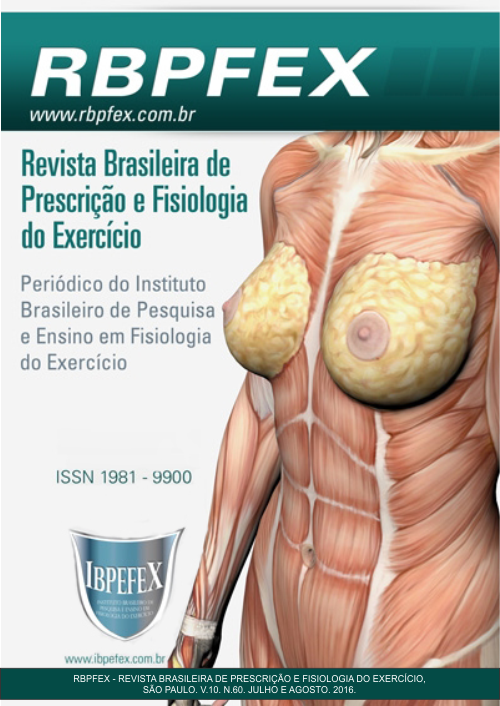Comparing the level of flexibility in practitionersteenagers and not volleyball players of a public school
Abstract
Summary: Flexibility is a topic widely studied and is very developed in the Physical Education classes today, based on the lifestyle that children bring. The aim of the study was to compare the level of flexibility in practitioners teenagers and not volleyball players of a public school in Manaus. The study included 30 students aged between 11 and 12 years, 15 practitioners of volleyball and 15 non-practicing, intentionally selected. The instrument used was the sit and reach test to measure flexibility, the study followed the instrument methodology for data analysis. There was no significant difference between practicing and non-practicing, concluding that the practice of volleyball did not interfere in the flexibility in this age group. In summary, we conclude that there was no difference between practicing and not volleyball players, so the practice of volleyball in this age group does not influence the flexibility.
References
-American College of Sports Medicine. Position stand.Quantity and quality of exercise for developing and maintaining cardiorespiratory, musculoskeletal, and neuromotor fitness in apparently healthy adults: guidance for prescribing exercise. Medicine and Science in Sports and Exercise, Hagerstown. Vol. 43. Num. 7. p. 1334-1359. 2011.
-Bergmann, G.G.; Araújo, M.L.B.; Garlipp, D.C.; Lorenzi, T.D.C.; Gaya, A. Alteração anual no crescimento e na aptidão física relacionada à saúde de escolares. Revista Brasileira de Cineantropometria e Desempenho humano. Vol. 7. Num. 2. p. 55-61. 2005.
-Bertolla, F.; Baroni, B.M.; Leal, E.C.P.; Oltramar, J.D. Efeito de um programa de treinamento utilizando o método Pilates na flexibilidade de atletas juvenis de futsal; Rev. Bras. Med Esporte. Vol. 13. Num. 4. 2007.
-Bloomfield, J.; Blanksby, B.A.; Berad, D.F.; Ackland, T.R.; Elliott, B.C. Biological characteristics of young swimmers, tennis players and non-competitors. Br J Sports Med. Vol. 18. p. 97-103. 1984.
-Farinatti, P.T.V. Flexibilidade e esporte: uma revisão da literatura. Rev. paul. Educ. Fís. 2000.
-Freitas, C.S. Flexibilidade dos Adolescentes Frequentadores do Projovem de São João da Aliança-GO. Alto Paraíso de Goiás: 2012.
-Gallahue, D.L.; Ozmun, J.C. Compreendendo o Desenvolvimento Motor: bebês crianças, adolescentes e adultos. São Paulo: Phorte. 2005.
-Gaya, A. Manual do Projeto Esporte Brasil, 2009.
-Gaya, A. Manual do Projeto Esporte Brasil, 2012.
-Guarnieri, A.T.A. A Importância do Trabalho de Flexibilidade em Jovens Atletas de Voleibol. Bauru: 2006.
-Matos, J.A.V. Associação entre valores do teste de flexibilidade e de resistência abdominal para ocorrência de dor e hiperlordose lombar. Revista de educação Ciência e Tecnologia do IFAM. Vol. 5. Num. 2. p. 29-41. 2015.
-Melo, F.A.P.; Oliveira, F.M.F.; Almeida, M.B. Nível de atividade física não identifica o nível de flexibilidade de adolescentes. Revista Brasileira de Atividade Física & Saúde. Vol. 14. Num. 1. p. 48-54. 2012.
-Minatto, G.; Ribeiro, R.R.; Achour Júnior, A.; Santos, K.D. Idade, maturação sexual, variáveis antropométricas e composição corporal: influência na flexibilidade. Revista Brasileira de Cineantropometria & Desempenho Humano. Vol. 12. Num. 3. p. 151-158. 2010.
-Montenegro, C.M.; Carvalho, G.A. Avaliação da flexibilidade em escolares do ensino fundamental na cidade de Manaus-AM. Revista Brasileira de Ciência e Movimento. Vol. 22. Num. 2. p. 5-12. 2014.
-Rassilan, E.A.; Guerra, T.C. Evolução da Flexibilidade em Crianças de 7 a 14 anos de Idade de uma Escola Particular do Município de Timóteo-MG. Movimentum. Vol. 1. p. 1-13. 2006.
-Sacramento, C.M. Avaliação da flexibilidade em escolares do ensino fundamental praticantes de aulas de educação física. Trabalho de Conclusão. Centro Universitário de Brasília. 2015.
Authors who publish in this journal agree to the following terms:
- Authors retain the copyright and grant the journal the right of first publication, with work simultaneously licensed under the Creative Commons Attribution License BY-NC which allows the sharing of the work with acknowledgment of the authorship of the work and initial publication in this journal.
- Authors are authorized to enter into additional contracts separately for non-exclusive distribution of the version of the work published in this journal (eg, publishing in institutional repository or book chapter), with acknowledgment of authorship and initial publication in this journal.
- Authors are allowed and encouraged to post and distribute their work online (eg, in institutional repositories or on their personal page) at any point before or during the editorial process, as this can bring about productive change as well as increase impact and impact. citation of published work (See The Effect of Free Access).






